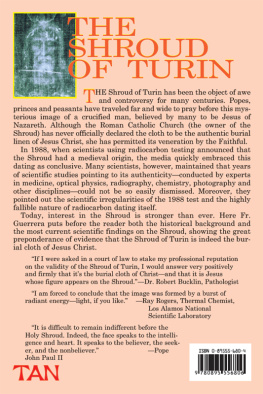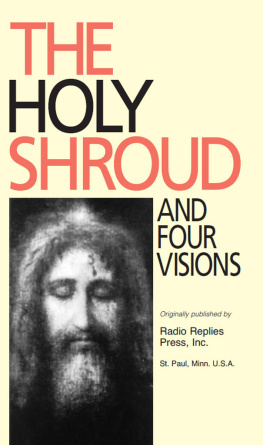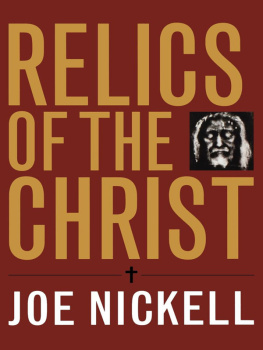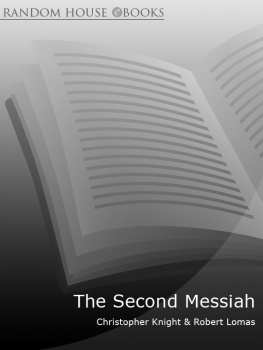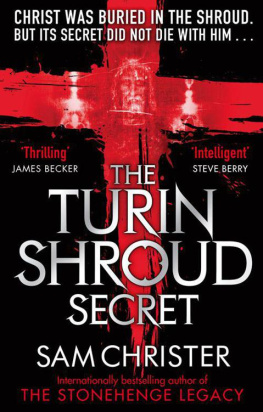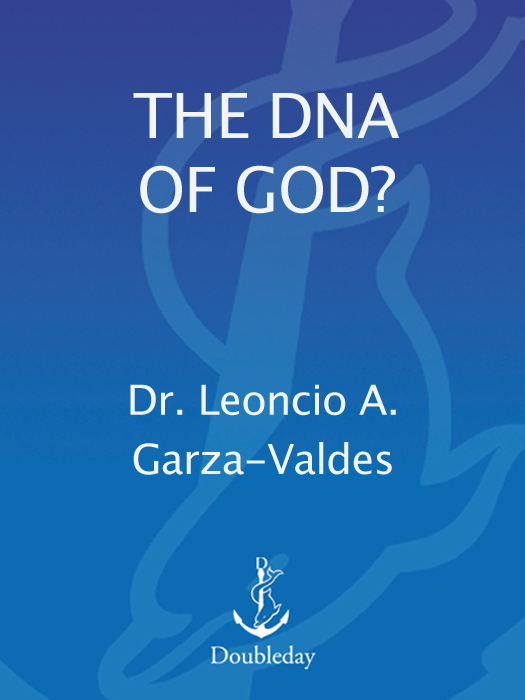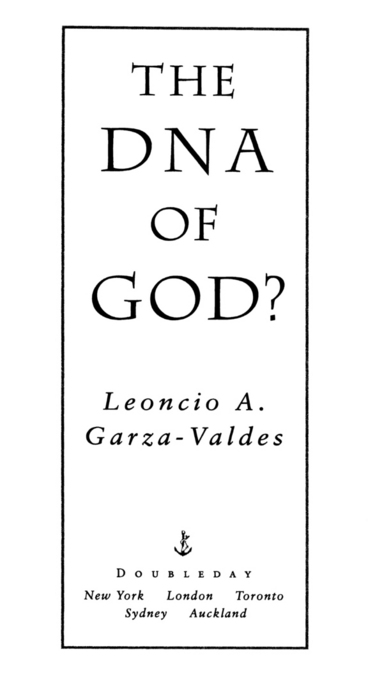PUBLISHED BY DOUBLEDAY
a division of Random House, Inc.
1540 Broadway, New York, New York 10036
D OUBLEDAY and the portrayal of an anchor with a dolphin are trademarks of Doubleday, a division of Random House, Inc.
Library of Congress Cataloging-in-Publication Data
Garza-Valdes, Leoncio A.
The DNA of God? / Leoncio A. Garza-Valdes. 1st ed.
p. cm.
1. Holy Shroud. I. Title.
BT587.S4G37 1999
232.966dc21 98-40568
eISBN: 978-0-307-81733-4
Copyright 1999 by Leoncio Garza-Valdes
All Rights Reserved
v3.1
To the memory of
F ATHER F AUSTINO C ERVANTES I BARROLA
December 5, 1917January 20, 1995
CONTENTS
Appendix D A N A CCELERATOR-BASED
M ASS S PECTROMETRY (H. G OVE )
ACKNOWLEDGMENTS
V ATICAN C ITY
His Holiness John Paul II
Bishop James Harvey
Mons. Paolo De Nicolo
Brother John Baldwin
T URIN
Luigi Gonella
Giovanni Riggi di Numana
Professor Franco A. Testore
M ICROBIOLOGY AT S ANTA R OSA H OSPITAL , S AN A NTONIO
Adolphus Smith
Teresa S. Widish
Vicky A. Fitzhugh
Victor Saldivar
M ICROBIOLOGY AT DSM, B RAUNSCHWEIG
Brian J. Tindall
M ICROBIOLOGY AT T ECHNICAL U NIVERSITY , M UNICH
Karl H. Schleifer
I NDUSTRIAL M ICROBIOLOGY AT W AGENINGEN , H OLLAND
Gerrit Eggink
P HYSICS
Harry E. Gove
C ENTER FOR A DVANCED DNA T ECHNOLOGY , S AN A NTONIO
Victor V. Tryon
Nancy Mitchell Tryon
A NTHROPOLOGY , U NIVERSITY OF T EXAS AT A USTIN
Brian Stross
T HEOLOGY , S T . M ARYS U NIVERSITY , S AN A NTONIO
Father John A. Leies, Ph.D.
F IVE R EVIEWERS OF THE F OURTH D RAFT
Ann Guthrie
Martha Magaly Huther
Ylda Isabel Huther
Jorge Martinez-Prieto
Carole Slade
D OUBLEDAY E DITORIAL D EPARTMENT
Trace Murphy
PREFACE
A THEOLOGICAL NOTE
The title of the book is provocative: The DNA of God? To some people it may seem irreligious or heretical or the attempt at a marketing ploy. Yet the title can be theologically defended.
In the first centuries of Christianity, the Church faced numerous efforts to explain the nature of Jesus of Nazareth, some of which were judged erroneous or misleading or dangerous. In the midst of examining the Christological questions, the Church developed a clear, official position: Jesus was both God and man, his nature as a human being was hypostatically joined to the divinity, he was of the same substance as God, at no time of his existence was he not God, and so on.
The issue of Jesus nature came to the forefront in discussions concerning the relationship of Mary of Nazareth, his mother, to Jesus, her son. The title Mother of God was used by many Christians in reference to Mary. But serious objections to that usage were raised by others.
At a Council of Ephesus in A.D . 431, the Christian Church solemnly proclaimed its belief: Mary rightly could be called not only the Mother of Jesus but also the Mother of God. At no time was Jesus not God. In becoming the mother of Jesus, she was by that very fact the mother of God.
It is then theologically true that whatever pertains to Jesus pertains to God: the body of Jesus can be said to be the body of God; the words of Jesus, the words of God; the blood of Jesus, the blood of God; and the components of the blood of Jesusthe DNA, for examplecan truly be said to be that of God.
It has not been proven that the man who was covered by the Shroud of Turin was Jesus of Nazareth. The question mark in the title indicates the uncertainty. But if it is the real Shroud of Jesus, then the bloodstains on itand their DNAare Gods.
R EV . J OHN A. L EIES , S.M. , S.T.D .,
St. Marys University, San Antonio, Texas
INTRODUCTION
T HE SCIENTIFIC STUDY OF ANCIENT ARTIFACTS, INCLUDING the Shroud of Turin, has taken me around the world, finding my way through unknown scientific territory and complicated political intrigues. The journey has been marked both by soaring exhilaration and by profound discouragement. But the moment that stays with me always, as a personal and professional turning point, is when I first saw and handled actual linen samples taken from the Shroud. I had long had an interest in it, deeply moved by the possibility that this piece of cloth was the one physical link to Jesus Christ remaining on the earth. But even beyond the personal involvement was my interest, as a medical doctor, in the Shroud itself. It was the high moment in a journey of scientific discovery that was to have profound implications.
Though it may sound strange, that journey has had little to do with faithbut everything to do with science. Many people acknowledge the authenticity of the Shroud of Turin as an article of faith, an identification to be accepted on trust alone rather than on facts. In the same way that few people think it worthwhile to attempt to prove scientifically the divinity of Jesus of Nazareth, I doubt the possibility of proving that the Shroud of Turin is truly the burial cloth of Jesus. But we live in an age of skepticism and try to explain all phenomena according to scientific criteria.
Although I have deep feelings in matters of faith (including the Shroud itself), I am more comfortable with the demands of science when seeking the truth. In fact, my entire professional life has been based on the scientific method. Research requires physical evidence; without it, the scientific method is useless. Accordingly, I am not about to offer judgment on a matter for which there is no evidence, that is, whether the Shroud is without doubt the burial cloth of Jesus, or whether the image on the Shroud was wrought through divine or supernatural means. I do not expect to lay to rest all the controversies that have surrounded the Shroud for centuries.
Yet even though I do not have answers for all these questions, I have gathered some extraordinary informationinformation that solves many of the mysteries of the Shroud and will have direct bearing for years to come on further study of the subject. Much of the physical evidence about the Shroud was never, until recently, studied with the aid of up-to-date scientific equipment and methods. Although some microscopic pieces of evidence raise further questions, I found them to offer insight into the Shrouds history. They helped me, and will undoubtedly be of use to scientists who will carry on the research in the years ahead.
The evidence I have found has broad implications. For example, my research has clarified many puzzles about the age of the Shroud, particularly the 1988 radiocarbon dating, whose proponents concluded that the Shroud does not date from the time of Jesus of Nazareth. I now know that this conclusion was mistaken, but the reasons were not apparent back in 1988.
I have discovered on the Shroud what I call a bioplastic coating, a type of clear encasing that is invisible to the unaided eye. Today, it looks to viewers like a shiny lamination, which is why some eyewitnesses say the Shroud has a surprising surface sheen. It is not, however, a manmade coating; it is actually composed of millions of living microbiological organisms that have formed over time, somewhat like a coral reef. This is a natural process I had earlier noted while doing research on other ancient artifacts. When the scientists used carbon dating on Shroud samples in 1988, they did not realize that they were dating, as one entity, both the original ancient fabric and this living bioplastic coating. Their mistaken result was off by centuries. My conclusion, based on evidence I have gathered, is that the Shroud of Turin is not a medieval fake, as was suggested, but is quite possibly a relic of the time of Jesus of Nazareth.



